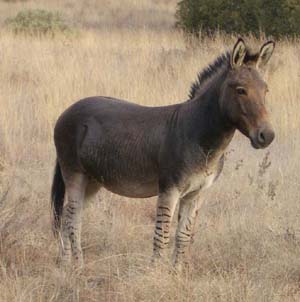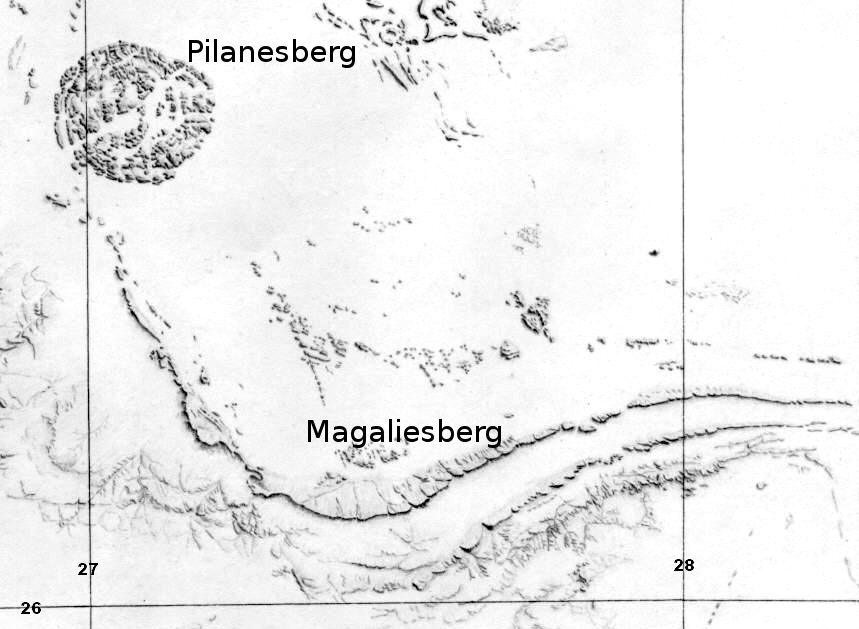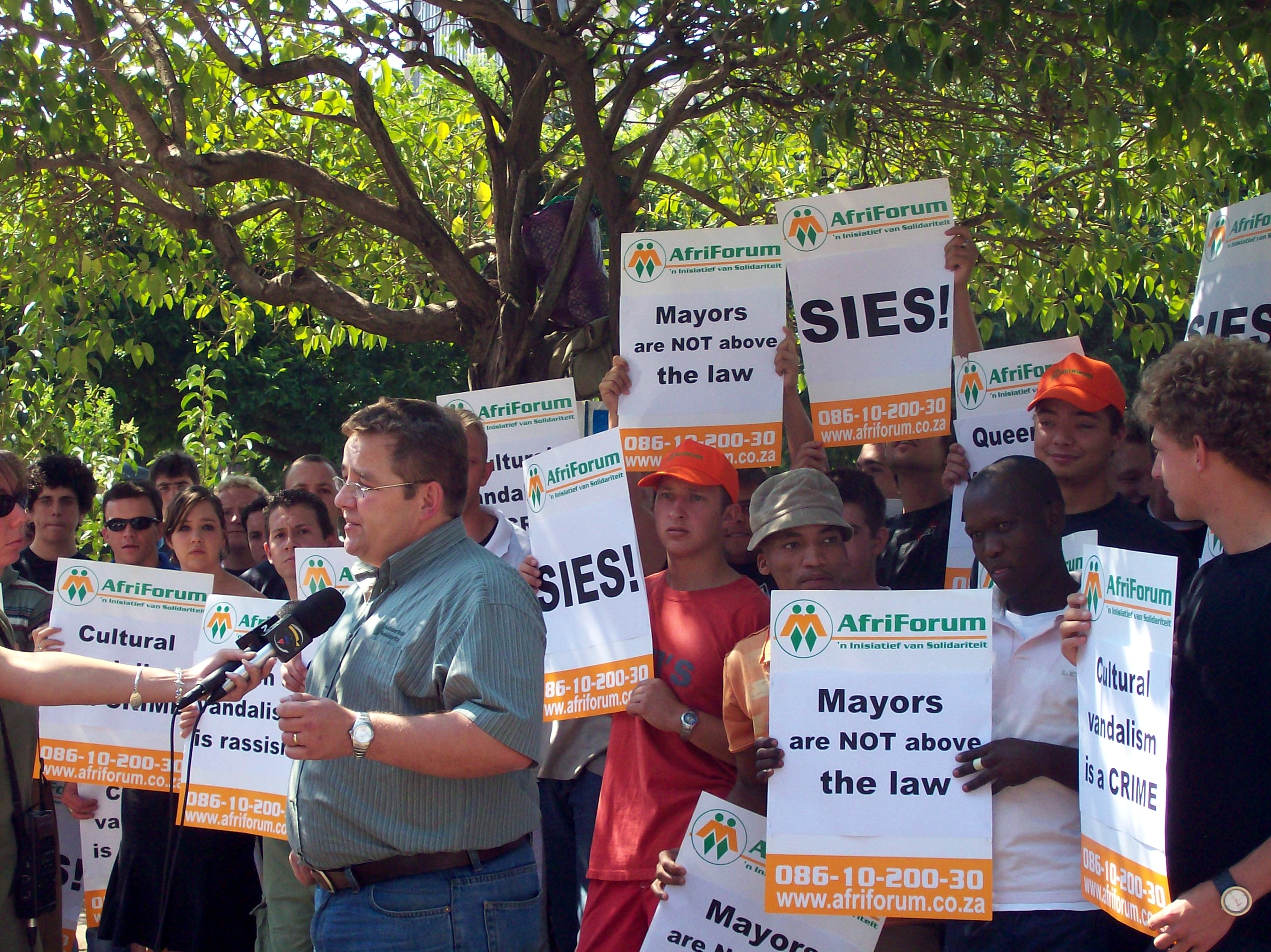|
Hennops River
The Hennops River is one of the larger rivers that drains Gauteng, South Africa. It has its source near Kempton Park, east of Johannesburg and meets the Crocodile River (Limpopo) shortly before Hartbeespoort Dam. It is one of Gauteng's most polluted rivers. Course The Hennops River starts in Terenure, Kempton Park, and flows in a northerly direction towards Tembisa township. It then flows past Olifantsfontein and meets the Sesmyl Spruit which flows out of the Rietvlei Dam. The river then turns north-west flowing through the centre of Centurion. The river continues in this direction flowing through the foothills of the Magaliesberg before flowing into the Crocodile River (Limpopo) on its right bank near the Hartbeespoort Dam. Dams The Rietvlei Dam, which provides water to City of Tshwane, as well as numerous farm dams are situated in the Hennops River Basin. Lake Centurion as well as numerous weirs are situated on the river. Pollution The Hennops River is one of Gaute ... [...More Info...] [...Related Items...] OR: [Wikipedia] [Google] [Baidu] |
South Africa
South Africa, officially the Republic of South Africa (RSA), is the southernmost country in Africa. It is bounded to the south by of coastline that stretch along the South Atlantic and Indian Oceans; to the north by the neighbouring countries of Namibia, Botswana, and Zimbabwe; and to the east and northeast by Mozambique and Eswatini. It also completely enclaves the country Lesotho. It is the southernmost country on the mainland of the Old World, and the second-most populous country located entirely south of the equator, after Tanzania. South Africa is a biodiversity hotspot, with unique biomes, plant and animal life. With over 60 million people, the country is the world's 24th-most populous nation and covers an area of . South Africa has three capital cities, with the executive, judicial and legislative branches of government based in Pretoria, Bloemfontein, and Cape Town respectively. The largest city is Johannesburg. About 80% of the population are Black South Afri ... [...More Info...] [...Related Items...] OR: [Wikipedia] [Google] [Baidu] |
Magaliesberg
The Magaliesberg (historically also known as ''Macalisberg'' or ''Cashan Mountains'') of northern South Africa, is a modest but well-defined mountain range composed mainly of quartzites. It rises at a point south of the Pilanesberg (and the Pilanesberg National Park) to form a curved prominence that intersects suburban Pretoria before it peters out some to the east, just south of Bronkhorstspruit. The highest point of the Magaliesberg is reached at Nooitgedacht Glacial Pavements, Nooitgedacht, about above sea level. A Hartbeespoort Aerial Cableway, cableway reaching to the top of the mountain range is located at Hartbeespoort Dam, providing sweeping views of the Magaliesberg and surrounding area. Geology The Magaliesberg has ancient origins. Its composition is ascribed to successive Geology, geological processes over a very protracted history. Its quartzites, shales, chert and Dolomite (rock), dolomite were deposited as sediments in an inland basin on top of a 3 billion year o ... [...More Info...] [...Related Items...] OR: [Wikipedia] [Google] [Baidu] |
Suspension Bridges
A suspension bridge is a type of bridge in which the deck is hung below suspension cables on vertical suspenders. The first modern examples of this type of bridge were built in the early 1800s. Simple suspension bridges, which lack vertical suspenders, have a long history in many mountainous parts of the world. Besides the bridge type most commonly called suspension bridges, covered in this article, there are other types of suspension bridges. The type covered here has cables suspended between towers, with vertical ''suspender cables'' that transfer the live and dead loads of the deck below, upon which traffic crosses. This arrangement allows the deck to be level or to arc upward for additional clearance. Like other suspension bridge types, this type often is constructed without the use of falsework. The suspension cables must be anchored at each end of the bridge, since any load applied to the bridge is transformed into a tension in these main cables. The main cables cont ... [...More Info...] [...Related Items...] OR: [Wikipedia] [Google] [Baidu] |
Picnic
A picnic is a meal taken outdoors ( ''al fresco'') as part of an excursion, especially in scenic surroundings, such as a park, lakeside, or other place affording an interesting view, or else in conjunction with a public event such as preceding an open-air theater performance, and usually in summer. It is different from other meals because it requires free time to leave home. History shows us that the idea of a meal that was jointly contributed to and enjoyed out-of-doors was essential to picnic from the early 19th century. Picnickers like to sit on the ground on a rug or blanket. Picnics can be informal with throwaway plates or formal with silver cutlery and crystal wine glasses. Tables and chairs may be used but this is less common. Outdoor games or some other form of entertainment are common at large picnics. In public parks, a picnic area generally includes picnic tables and possibly built-in grills, water faucets (taps), garbage (rubbish) containers and restrooms (toi ... [...More Info...] [...Related Items...] OR: [Wikipedia] [Google] [Baidu] |
Camping
Camping is an outdoor activity involving overnight stays away from home, either without shelter or using basic shelter such as a tent, or a recreational vehicle. Typically, participants leave developed areas to spend time outdoors in more natural ones in pursuit of activities providing them enjoyment or an educational experience. The night (or more) spent outdoors distinguishes camping from day-tripping, picnicking, and other similarly short-term recreational activities. Camping as a recreational activity became popular among elites in the early 20th century. With time, it grew in popularity among other socioeconomic classes. Modern campers frequent publicly owned natural resources such as national and state parks, wilderness areas, and commercial campgrounds. In a few countries, such as Sweden and Scotland, public camping is legal on privately held land as well. Camping is a key part of many youth organizations around the world, such as Scouting, which use it to teach bot ... [...More Info...] [...Related Items...] OR: [Wikipedia] [Google] [Baidu] |
Hiking
Hiking is a long, vigorous walk, usually on trails or footpaths in the countryside. Walking for pleasure developed in Europe during the eighteenth century.AMATO, JOSEPH A. "Mind over Foot: Romantic Walking and Rambling." In ''On Foot: A History of Walking'', 101-24. NYU Press, 2004. Accessed March 1, 2021. http://www.jstor.org/stable/j.ctt9qg056.7. Religious pilgrimages have existed much longer but they involve walking long distances for a spiritual purpose associated with specific religions. "Hiking" is the preferred term in Canada and the United States; the term "walking" is used in these regions for shorter, particularly urban walks. In the United Kingdom and the Republic of Ireland, the word "walking" describes all forms of walking, whether it is a walk in the park or backpacking in the Alps. The word hiking is also often used in the UK, along with rambling , hillwalking, and fell walking (a term mostly used for hillwalking in northern England). The term bushwalking is end ... [...More Info...] [...Related Items...] OR: [Wikipedia] [Google] [Baidu] |
Non-governmental Organization
A non-governmental organization (NGO) or non-governmental organisation (see spelling differences) is an organization that generally is formed independent from government. They are typically nonprofit entities, and many of them are active in humanitarianism or the social sciences; they can also include clubs and associations that provide services to their members and others. Surveys indicate that NGOs have a high degree of public trust, which can make them a useful proxy for the concerns of society and stakeholders. However, NGOs can also be lobby groups for corporations, such as the World Economic Forum. NGOs are distinguished from international and intergovernmental organizations (''IOs'') in that the latter are more directly involved with sovereign states and their governments. The term as it is used today was first introduced in Article 71 of the newly-formed United Nations' Charter in 1945. While there is no fixed or formal definition for what NGOs are, they are genera ... [...More Info...] [...Related Items...] OR: [Wikipedia] [Google] [Baidu] |
Eutrophication
Eutrophication is the process by which an entire body of water, or parts of it, becomes progressively enriched with minerals and nutrients, particularly nitrogen and phosphorus. It has also been defined as "nutrient-induced increase in phytoplankton productivity". Water bodies with very low nutrient levels are termed oligotrophic and those with moderate nutrient levels are termed mesotrophic. Advanced eutrophication may also be referred to as dystrophic and hypertrophic conditions. Eutrophication can affect freshwater or salt water systems. In freshwater ecosystems it is almost always caused by excess phosphorus. In coastal waters on the other hand, the main contributing nutrient is more likely to be nitrogen, or nitrogen and phosphorus together. This depends on the location and other factors. When occurring naturally, eutrophication is a very slow process in which nutrients, especially phosphorus compounds and organic matter, accumulate in water bodies. These nutrients deriv ... [...More Info...] [...Related Items...] OR: [Wikipedia] [Google] [Baidu] |
Escherichia Coli
''Escherichia coli'' (),Wells, J. C. (2000) Longman Pronunciation Dictionary. Harlow ngland Pearson Education Ltd. also known as ''E. coli'' (), is a Gram-negative, facultative anaerobic, rod-shaped, coliform bacterium of the genus ''Escherichia'' that is commonly found in the lower intestine of warm-blooded organisms. Most ''E. coli'' strains are harmless, but some serotypes ( EPEC, ETEC etc.) can cause serious food poisoning in their hosts, and are occasionally responsible for food contamination incidents that prompt product recalls. Most strains do not cause disease in humans and are part of the normal microbiota of the gut; such strains are harmless or even beneficial to humans (although these strains tend to be less studied than the pathogenic ones). For example, some strains of ''E. coli'' benefit their hosts by producing vitamin K2 or by preventing the colonization of the intestine by pathogenic bacteria. These mutually beneficial relationships between ''E. col ... [...More Info...] [...Related Items...] OR: [Wikipedia] [Google] [Baidu] |
AfriForum
AfriForum is a South African non-governmental organisation focused mainly on the interests of Afrikaners, a subgroup of the country's white population. AfriForum has been frequently described as a white nationalist, alt-right, and Afrikaner nationalist group, a description rejected by the organisation's leadership, who refer to themselves as a civil rights group. Established in 2006 to encourage the re-engagement of Afrikaners in the public sphere, it is closely affiliated to the Solidarity trade union, and has attracted significant controversy because of a statement by its leader, Kallie Kriel, that Apartheid was not a crime against humanity. A court, however, ruled that "Kriel did not justify Apartheid or align himself with the racial discriminatory policies of the past. He stated unequivocally that Apartheid was wrong and that it was a system that infringed on the dignity of people". History AfriForum was founded in 2006 following public consultations about its charter. In t ... [...More Info...] [...Related Items...] OR: [Wikipedia] [Google] [Baidu] |
Erasmia
Erasmia is a suburb in the northern outskirts of Centurion in the City of Tshwane Metropolitan Municipality. Originally a whites-only area under apartheid, increasing numbers of Indians from neighbouring Laudium moved in, following the abolition of segregation in the early 1990s, and the construction of a direct link road between the two areas. Erasmia lies west of the R55 route The R55 is a north-south provincial route in Gauteng, South Africa that connects Sandton with Pretoria. It passes Woodmead, Kyalami, Olievenhoutbosch, Heuweloord, Sunderland Ridge, Erasmia, Laudium/Claudius, West Park, the Daspoort Tunnel .... In 2001, 65.72% of the population was Indian, ''Census 2001'' and by 2011, Indians made up 77.03% of the population. The area called Christoburg is for census [...More Info...] [...Related Items...] OR: [Wikipedia] [Google] [Baidu] |
Ivory Park
Ivory Park is a densely populated residential suburb of Midrand in the Gauteng province of South Africa. It is located in Region A of the City of Johannesburg Metropolitan Municipality, City of Johannesburg. Ivory Park is occupied by more than 182 000 black people and is located in the town of Midrand in the City of Johannesburg Metropolitan Municipality. It is situated adjacent to the township of Tembisa in the neighbouring City of Ekurhuleni Metropolitan Municipality and is usually but inaccurately treated as being part of it. Services in Ivory Park have improved since the early 1990s. It has five clinics, eight schools, a police station, two libraries and is served by the popular Voice of Tembisa FM community radio station. References Johannesburg Region A Townships in Gauteng {{Johannesburg-stub ... [...More Info...] [...Related Items...] OR: [Wikipedia] [Google] [Baidu] |








